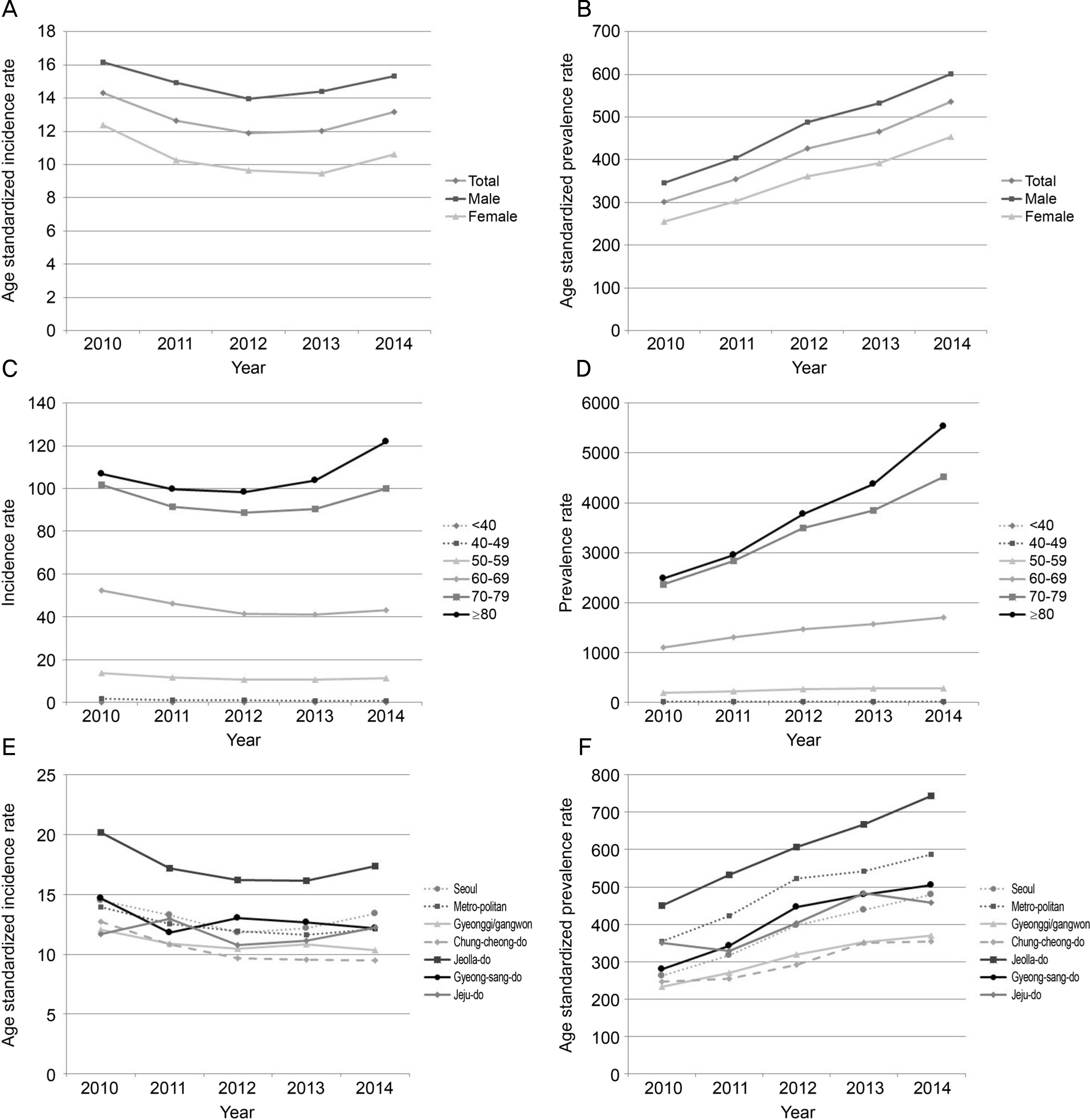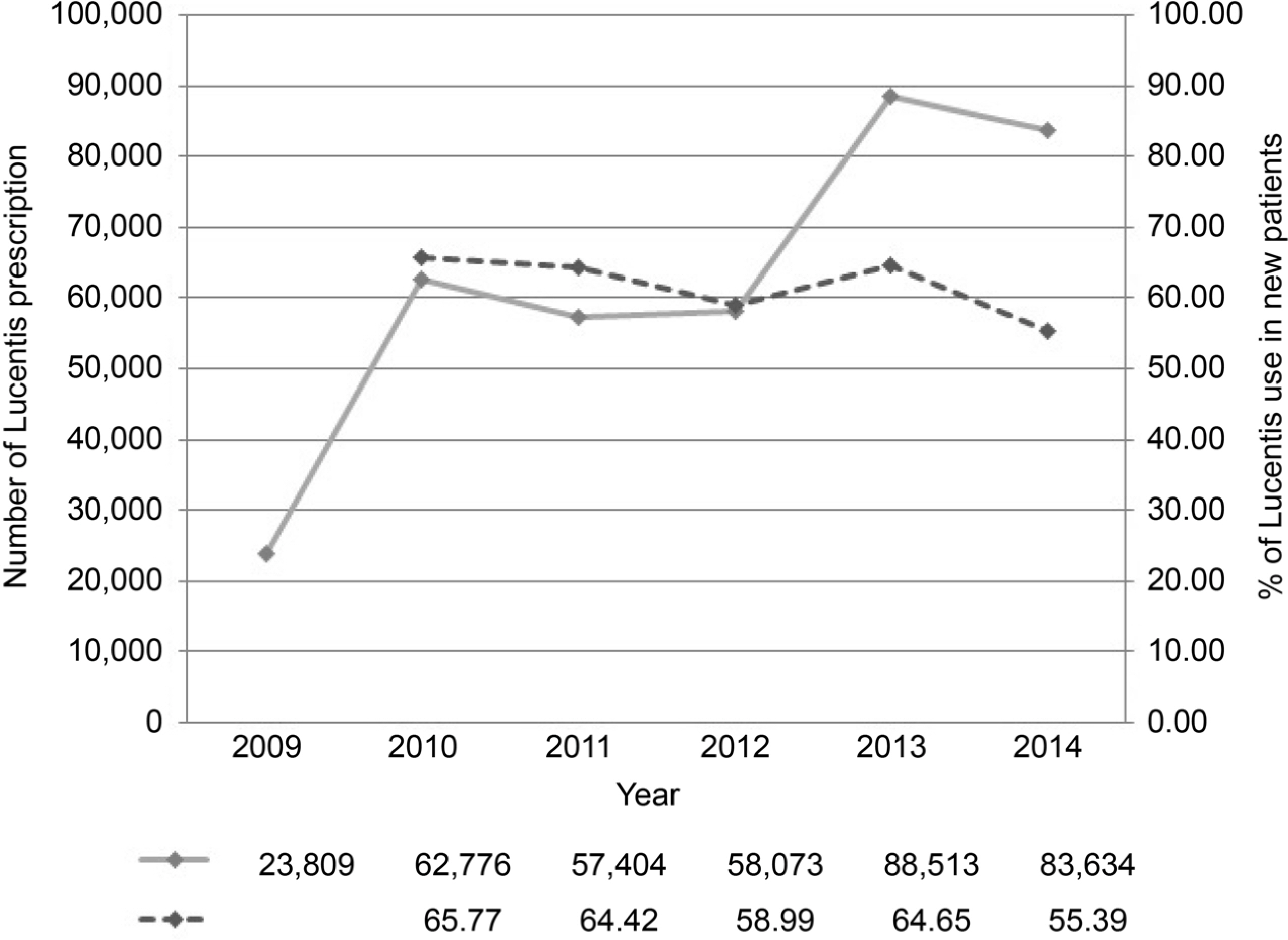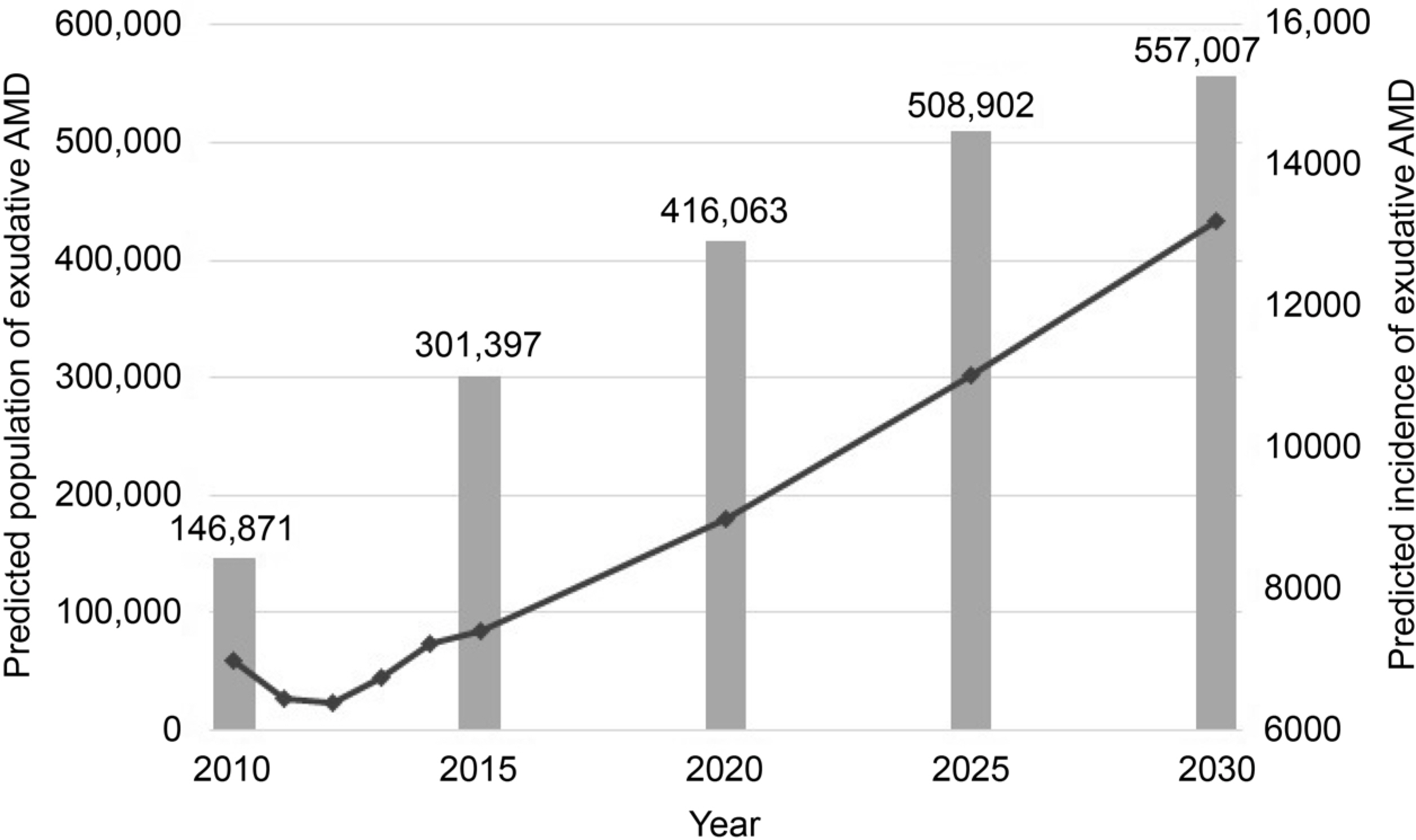J Korean Ophthalmol Soc.
2019 Mar;60(3):253-260. 10.3341/jkos.2019.60.3.253.
Prevalence of Exudative Age-related Macular Degeneration and Projections of the Cost of Ranibizumab in Korea
- Affiliations
-
- 1Department of Ophthalmology, National Health Insurance Service Ilsan Hospital, Goyang, Korea. plusm13@gmail.com
- 2Policy Research Affairs, National Health Insurance Service Ilsan Hospital, Goyang, Korea.
- 3Department of Ophthalmology, Yonsei University College of Medicine, Seoul, Korea.
- KMID: 2440453
- DOI: http://doi.org/10.3341/jkos.2019.60.3.253
Abstract
- PURPOSE
To analyze the incidence and prevalence of exudative age-related macular degeneration (AMD) and to predict the future AMD populations and health expenditures of intravitreal ranibizumab injection.
METHODS
From 2010 to 2014, the National Health Insurance claims data were used to estimate the incidence and prevalence change of exudative AMD, according to demographic characteristics (year, sex, residence, and age). Based on the above results and changes in future population distribution, we estimated the AMD population by 2030. Considering the cost of Intravitreal ranibizumab injection from 2010 to 2014, we predicted the future health expenditure for AMD.
RESULTS
The incidence and prevalence of exudative AMD increased from 14.04 and 295.11 per 100,000 populations in 2010 to 14.25 and 580.71 in 2014, respectively. The prevalence rate was higher in men and showed a large increase over 70 years of age. The ranibizumab was prescribed 13 times per person in average, and the amount consumed increased as the number of insurance coverage increased from 2013. Future AMD populations are predicted to reach 557,007 in 2030 from 146,871 in 2014. As a result, the cost of intravitreal ranibizumab injection is expected to increase from 83.6 billion won in 2014 to 171.7 billion won in 2030.
CONCLUSIONS
The increase in medical expenses for AMD is expected due to social aging. Therefore, we need policies to secure medical resources and expand insurance indications.
MeSH Terms
Figure
Reference
-
References
1. Congdon N, O'Colmain B, Klaver CC, et al. Causes and prevalence of visual impairment among adults in the United States. Arch Ophthalmol. 2004; 122:477–85.2. Klein R, Klein BE, Linton KL. Prevalence of age-related maculopathy. The Beaver Dam Eye Study. Ophthalmology. 1992; 99:933–43.3. World Health Organization. Vision 2020: the right to sight. Global initiative for the elimination of avoidable blindness: action plan 2006–2011. http://apps.who.int/iris/handle/10665/43754. Accessed February 24, 2014.4. Lee PP, Feldman ZW, Ostermann J, et al. Longitudinal prevalence of major eye diseases. Arch Ophthalmol. 2003; 121:1303–10.
Article5. Rein DB, Wittenborn JS, Zhang X, et al. Forecasting age-related macular degeneration through the year 2050: the potential impact of new treatments. Arch Ophthalmol. 2009; 127:533–40.6. Wong WL, Su X, Li X, et al. Global prevalence of age-related abdominal degeneration and disease burden projection for 2020 and 2040: a systematic review and meta-analysis. Lancet Glob Health. 2014; 2:e106–16.7. Park SJ, Lee JH, Woo SJ, et al. Age-related macular degeneration: prevalence and risk factors from Korean National Health and Nutrition Examination Survey, 2008 through 2011. Ophthalmology. 2014; 121:1756–65.8. Cho BJ, Heo JW, Kim TW, et al. Prevalence and risk factors of age-related macular degeneration in Korea: the Korea National Health and Nutrition Examination Survey 2010–2011. Invest Ophthalmol Vis Sci. 2014; 55:1101–8.
Article9. Statistics Korea. Population Projections for Korea: 2010–2060 (Based on the 2010 Census). Korean Statistical Information Service. http://kosis.kr/publication/publicationThema.do. Accessed August 1, 2012.10. Statistics Korea. Population Statistics Based on Resident Registration 2014. Korean Statistical Information Service. http://kosis.kr/pub-lication/publicationThema.do. Accessed March 1, 2018.11. Rim TH, Choi M, Yoon JS, Kim SS. Sociodemographic and health behavioural factors associated with access to and utilisation of eye care in Korea: Korea Health and Nutrition Examination Survey 2008–2012. BMJ Open. 2015; 5:e007614.
Article12. Hyun KR, Kang S, Lee S. Population aging and healthcare expenditure in Korea. Health Econ. 2016; 25:1239–51.
Article
- Full Text Links
- Actions
-
Cited
- CITED
-
- Close
- Share
- Similar articles
-
- Incidence of New Choroidal Neovascularization in Fellow Eyes of Patients Treated for Age-Related Macular Degeneration
- Association between Ranibizumab Injections and Risk of Acute Myocardial Infarction in Age-related Macular Degeneration: A Case-crossover Study
- Clinical Changes after Switching from Ranibizumab/Aflibercept to Bevacizumab in Exudative Age-related Macular Degeneration
- One-year Outcomes of a Treat-and-extend of Ranibizumab for Naive Exudative Age-related Macular Degeneration: Retrospective Analysis
- Current Smoking Is Associated with a Poor Visual Acuity Improvement after Intravitreal Ranibizumab Therapy in Patients with Exudative Age-Related Macular Degeneration




